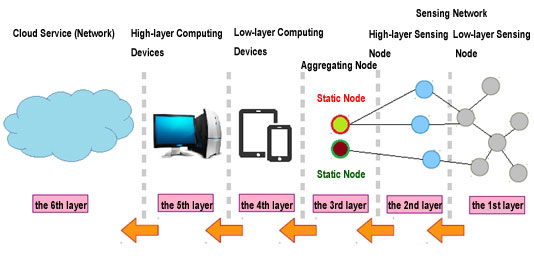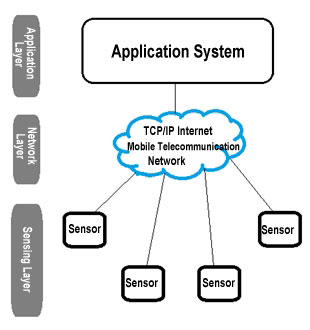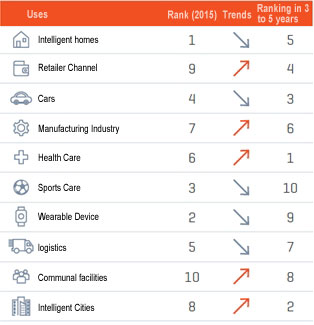Talk on Internet of Things and its Trends
Author/Ke Jingxiang [Issue Date: 2016/1/1]
Definition
The term Internet of Things (IOT) is also referred to as Internet of Everything (IoE). The term was coined in 1999 by Kevin Ashton at MIT's Auto ID Center when he introduced the concept, ”…Internet of Things has a potential ability to change world, just like the Internet, and even in more far-reaching degree.” [Note 1] It is a concept basing on the existing network system, and the definitions given by various studies are not the same for it is still in the preliminary stage. [Note 2] [Note 3] However ”The Internet of Things allows people and things to be connected Anytime, Anyplace, with Anything and Anyone, ideally using Any path / network and Any service.” [Note 4]
Development
In 1997, Kevin Ashton, then responsible for marketing care products at Procter & Gamble (P&G), in several tours, noticed that hazelnut oil lipstick is always in short at supply for British retailers. He tried to find solutions, and tried to introduce Radio Frequency Identification (RFID) to manage P&G's supply chain [Note 5] [Note 6]. Although RFID was expensive at the time, he knew that mass production would lower the costs, that is to say, bulk buying would reduce cost. Finally, he succeeded in improving issues relating to the supply chain. One year later, Ashton served as Executive Director in the MIT Auto ID Center. During the following year he promoted the concept of the Internet of Things. After ten years to date, the Internet of Things starts for a short period of time and face many challenges in applications.
Architecture
In the Internet of Things, the underlying sensing node gathers information that is then sent to the sensing aggregating node to support high-layer computing devices, or further transferred to the cloud network to be shared, stored or reused. The entire system architecture may take many forms and is not limited to the form shown in Figure 1.

However, the common architecture of the Internet of Things is a three-layer architecture [Note 10] designed by the European Telecommunications Standards Institute (ESTI) shown in figure II. This architecture consists of a bottom sensing layer, a middle network layer and a top application layer. As the development base of the Internet of Things, the sensing layer consists of a variety of sensing and communicating devices, for sensing and detecting environmental information, such as sound, temperature, humidity, brightness, and speed. The relevant information is then sent to the network layer. The network layer consists of a variety of wired and wireless network technologies, and gathers all the node devices. When necessary, it integrates heterogeneous networks and sends the confluence of information to the Internet of Things computing center for processing. The application layer analyzes data according to customer demand to provide a wide range of applications in various fields.

1. Sensing Layer
This layer is primarily bases on sensors. A general sensor is a kind of physical device, capable of detecting external signals. The principle is to detect chemical and physical variables that can be measured via a sensor component, and then the conversion component converts relevant signals to electric signals, namely energy from one form to another. [Note 11] [Note 12]
Common sensors include sound sensors, vehicle sensors, chemical sensors, electromagnetic sensors, fluid sensors, particle sensors, navigation sensors, electronic compass, acceleration sensors, photosensing units, pressure sensors, mechanical sensors, density sensors, temperature sensors, and so on. [Note 13]
It can be seen that sensors are mostly specific sensitive components. Given the appropriate sensor, selected according to the purpose at-hand, we can detect the specific scene, and gather and store a lot of target information, and then send this information to users or application systems for computing through the network layer.
2. Network Layer
To share information with each other, the components must be able to access the Internet of Things. The communication technologies of the Internet of Things are built on web platforms that are familiar to us, and uses various wireless network, such as short-distance and long-distance wireless technologies. The short-distance wireless technology is able to cover areas from several meters to several hundred meters, including Bluetooth, RFID, NFC, UWB, WiFi, ZigBee or infrared transmission. The long-distance wireless technologies are able to cover areas at least 1 km, including 3G, WiMax, LTE.
Given these wireless technologies, we can see that each sensing unit has a variety of means of communication available to share information with each other. Although protocols of each wireless communication vary, as long as the gateway of an heterogeneous wireless network is integrated, various network protocols are able to communicate with each other, thereby allowing the sensing layer and the application layer to be linked.
3. Application Layer
The world's top 50 applications of sensors listed by Spain sensor-based technology company are as follows: [Note 14]
1. Intelligent City
(1) Intelligent Parking: Monitor available parking spaces
(2) Status of Building: Monitor status of buildings, bridges and monuments
(3) Map of City Noise: Real-time monitoring of noise in downtown areas
(4) Intelligent Mobile Detection: Detect mobile phones' communication interface, Bluetooth or Wifi
(5) Intensity of Electromagnetic Field: Detect the intensity of a base station or Wifi router
(6) Traffic Congestion: Monitor vehicles and pedestrians for optimization
(7) Intelligent Lighting: Automatically adjust the lighting according to weather conditions
(8) Waste Management: Monitor the status of trash cans to optimize recycling routes of garbage trucks
(9) Intelligent Road: Provide highway warnings and diversion message according to weather and road conditions
2. Intelligent Environment
(1) Forest fires: Monitor combustion gases and fire situations to ascertain warning areas
(2) Air pollution: Control emissions of carbon dioxide, car exhaust gases, and toxic gases on farms
(3) Extent of snow cover: Real-time monitoring of snow conditions to inform relevant personnel for avalanche prevention
(4) Landslide: Monitor soil moisture, vibration and surface density to prevent danger on road surfaces
(5) Early Detection of Earthquake: Deploy controls according to the distribution of earthquakes
3. Intelligent Hydraulic Power
(1) Natural Water Monitoring: Monitor water quality in urban areas
(2) River Pollution: Monitor whether there is manufacturing wastewater in rivers
(3) Status of Pool: Remotely monitor quality of water in the swimming pool
(4) Marine Pollution: Monitor seawater is contaminated
(5) Pipeline Leakage: Monitoring leaks and line pressure changes
(6) Flood Status: Monitor flow changes of rivers and reservoirs
4. Intelligent Electricity Meter
(1) Intelligent Grid: Monitor and manage energy consumption
(2) Tank Monitoring: Monitor water tank and gas tank pressure
(3) Deployment of Solar Installations: Monitor the installation effectiveness of solar panels
(4) Storage Calculation: Measure delivery pressure
5. Security and Strain
(1) Boundary Access Control: Control restricted areas to prevent unauthorized users from access
(2) Humidity Control: Monitor leaks in important building sites to avoid breakage and corrosion
(3) Degree of Radiation: Distributed monitoring of radiation situations around nuclear plants for immediate leak alarm
(4) Flammable Materials and Hazardous Gases: Monitor the degree of hazardous gas around factories or mines
6. Retail Channel
(1) Supply Chain Control: Monitor the production of a supply chain to provide product tracking
(2) Electronic Payment NFC: Provide payment services at places of business
(3) Intelligent shopping: Provide buying advice according to a customer's habits, hobbies, etc.
(4) Intelligent Storage Management: Control inventory turnover on retail shelves and in warehouses to automatically manage stock
7. Logistics
(1) Freight Status: Monitor goods transit status: vibrated, tapped, opened or chilled
(2) Determine Goods' Position: Look for the goods among a large amount of goods in the warehouse or port
(3) Dangerous Goods Detection: Send alarms when near flammable items
(4) Route Tracking: Preform route management for special items, such as drugs, jewelry or dangerous goods
8. Industrial Control
(1) M2M Applications: Device automatic diagnostics and asset management
(2) Indoor Air Quality: Monitor gas levels at chemical plants to protect the security of workers and goods
(3) Temperature Monitoring: Control the temperature of industrial or medical refrigeration units for sensitive goods
(4) Ozone Detection: Monitor the status of discharged ozone during meat processing
(5) Determine Indoor Position: Locate assets in the active mode Zigbee or passive mode RFID/NFC
(6) Automatic Diagnosis for Vehicles: Collecting information with CanBus to send alarms or suggestions to drivers
9. Intelligent Agriculture
(1) Improve wine quality: Monitor vineyard soil moisture and trunk diameter to control grape quality
(2) Monitor Greenhouse: Control climate in the greenhouse to maximize crop output and quality
(3) Golf course: Water drying areas to conserve water
(4) Meteorological network: Study weather in the area to forecast weather change
(5) Compost: Control compost temperature and humidity to avoid fungal and microbial contamination
10. Intelligent Farming
(1) Water-cultivation: Control status of plants in water to improve harvest
(2) Livestock Monitoring: Monitor growth of livestock on a farm to ensure survival rate and health
(3) Animal Tracking: locate animals raised in an open ranch or a large area
(4) Toxic Gas Monitoring: Monitor ranch ventilation conditions to prevent harmful gases due to accumulation of feces
11. Intelligent Home
(1) Usage of water and electricity: Monitor home water and electricity usage to get advice about saving money
(2) Remote Control: Remotely control switches to avoid accidents and save energy
(3) Intrude Detection System: Monitor whether the system is forcibly intruded
(4) Monitor Valuable items: Monitor the situation of museums and galleries
12. E-care
(1) Care for the elderly: Help the elderly and the disabled when living alone
(2) Pharmaceutical Refrigerator. Control storage of vaccines and drugs in need of cryopreservation
(3) Care for Athletes: Monitor vital signs in exercise center
(4) Patient Monitoring: Monitor the condition of patients in rest homes
(5) UV monitoring: Monitor ultraviolet levels to avoid over exposure
In addition, according to the analysis based on 678 investigations [15] among America, Britain, France, German, Sweden and the Netherlands released by Progress, an international software company, NASDAQ: PRGS, in 2015, currently the primary market for the Internet of Things is intelligent homes (about 19%), followed by wearable devices (about 13%) and next automatic vehicle equipment (about 11%) followed by sports care (about 11%).
Looking back, we can see that in the past three to five years, the three areas having the most project activity were: health care is the mainstream (about 14%), followed by intelligent cities (about 13%) and automatic vehicle equipment (about 12%).

Challenges
IBM proposed five difficulties confronting them in 2015 [16]. Only after relevant solutions are proposed, the public would enjoy the security and convenience brought about by the Internet of Things. The five difficulties are as follows:
1. Networking Cost Too Great
Because currently the scale of the Internet of Things has not yet reached the market’s expectations, a variety of the infrastructures of clouds and large servers and maintenance are too expensive. In addition, apart from hardware, service charges of intermediate software vendors also result in high networking cost of Internet of Things.
2. Low trust of the Internet
Network reliability here means network security and privacy issues. ‘When objects and devices around lives link into a large-scale intelligent network, their data can provide convenience, but also becomes the path to privacy leaks which are likely to become an important tool for cybercrime.’[17]
If personal information leaks, usage record of household water for example, or a monitor's security is compromised, strangers are easily able to glean the habits of those persons including home security. On the other hand, also worrisome in regard to national security is a situation where database records are stolen by interested persons for amusement or other reward; however, relevant devices cannot protected by security mechanisms because general sensors are not able to include the associated encryption programs due to hardware limitations. This is one of the most important issues — get users’ support by achieving security for the Internet of Things and reducing risks.
3. Not because of the future
Consumers phones have a short life-span, but the life of infrastructures of the Internet of Things may take several years, therefore, the subsequent cost of upgrade and maintenance of software will result in enormous pressure in enterprises.
4. Lack of Functional Value
There are currently many solutions available for the Internet of Things, however but most of them merely emphasize online but lack meaningful value so they are not able to give users a better experience.
5. Incomplete Business Model
Currently the Internet of Things business mode is based mostly on selling users’ data and advertisements, therefore the actual revenue will belong to the relevant integrators. Given this uncertain business model, it may be overly optimistic that the market is able to react to the cost of many applications.
Conclusions
Nowadays a great deal of information can be shared via social platforms like Facebook. After the Internet of Things steps into the modern Internet, the information will no longer be shared by the people who input it, but be automatically passed to users or applications via the Internet after intelligent objects response to environmental change. We can see the convenience brought by the development of the Internet, for example, it allows us to have a real-time master of all the objects and simplify the procedures to deal with things, improving the quality of life to a certain extent and creating a new lifestyle for us.
Reference Materials
[Note 1]K. Ashton, “That ’internet of things’ thing in the real world, things matter more than ideas,” RFID Journal, June 2009, http://www.rfidjournal.com/article/print/4986 [Accessed on: 2012-07-30].
[Note 2]European Commission, “Internet of things in 2020 road map for the future,” Working Group RFID of the ETP EPOSS, Tech. Rep., May 2008, http://ec.europa.eu/information society/policy/rfid/documents/iotprague2009.pdf[Accessed on: 2011-06-12].
[Note 3]T. Lu and W. Neng, “Future internet: The internet of things,” in 3rd International Conference on Advanced Computer Theory and Engineering(ICACTE), vol. 5, August 2010, pp. V5–376–V5–380. [Online]. Available: http://dx.doi.org/10.1109/ICACTE.2010.5579543
[Note 4]P. Guillemin and P. Friess, “Internet of things strategic research roadmap,” The Cluster of European Research Projects, Tech. Rep., September 2009, http://www.internet-of-things-research.eu/pdf/IoT_Cluster_Strategic_Research_Agenda_2009.pdf[Accessed on: 2011-08-15].
[Note 5]http://www.rfidjournal.com/articles/view?4986
[Note 6]http://archive.wired.com/wired/archive/12.07/shoppers.html?pg=1&topic=shoppers&topic_set=
[Note 7]C. Perera, A. Zaslavsky, P. Christen, D. Geogakopoulos, “Context Aware Computing for The Internet of Things: A Survey” (2013), pp. 1–41
[Note 8]From Internet to Internet of Things
[Note 9]Internet of Things Allows Everything Communicated
[Note 10]ETSI TS 102 690 v2.1.1 (2013),Machine-to-Machine communications(M2M): Functional architecture
[Note 11]Zeng Yuqi, Lin Zhingkuan, Lin Zhiyu, Pan Mengxuan, "Wireless Network: Protocols, Sensor Networks, Services and Applications of Radio Frequency Technology" Acer Peak Press, 2011.
[Note 12]https://en.wikipedia.org/wiki/Sensor
[Note 13]https://en.wikipedia.org/wiki/List_of_sensors
[Note 14]http://www.libelium.com/top_50_iot_sensor_applications_ranking/
[Note 15]https://www.progress.com/docs/default-source/default-document-library/progress/documents/papers/iot_surveyreport.pdf
[Note 16]http://www.ibm.com/news/tw/zh/2015/01/22/O058049T47476R20.html
[Note 17]Zhao Zhihong, Liu Chuangang, Li Zhongxian (2015). Convenience and Crisis of Internet of Things. Science Development in the 512nd issue of August, 2015, 10-13
